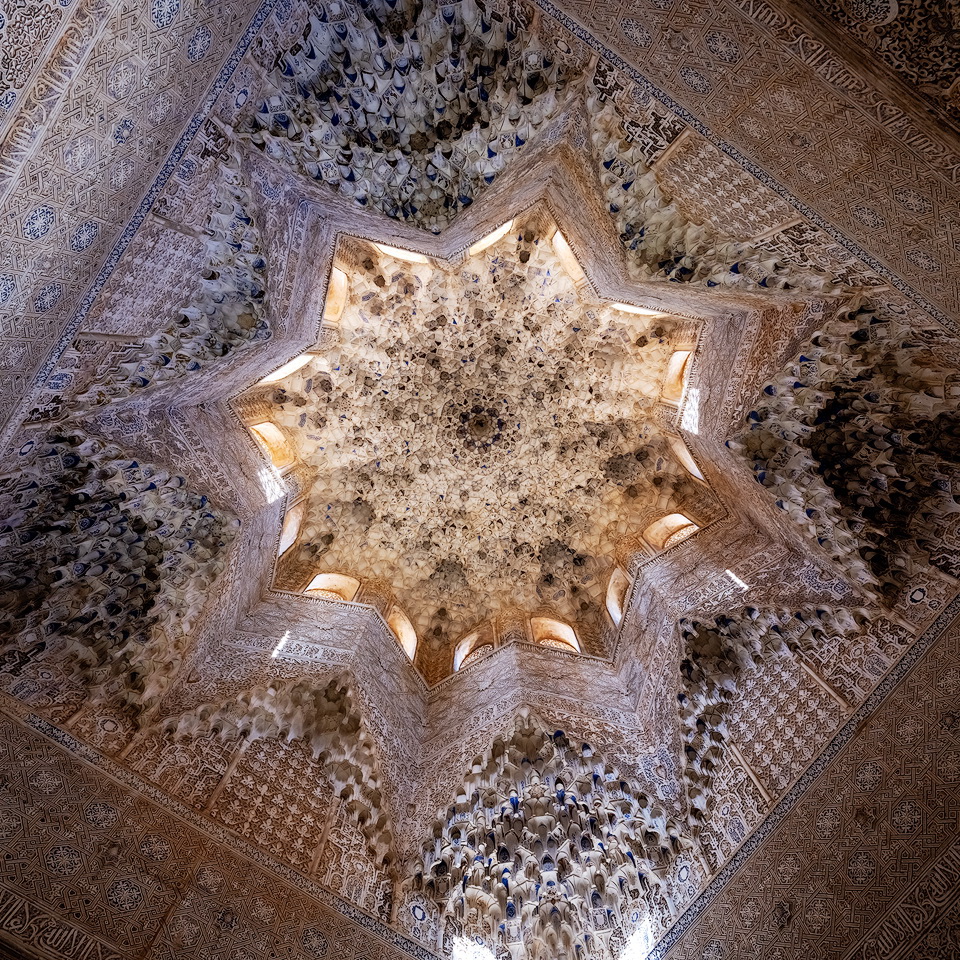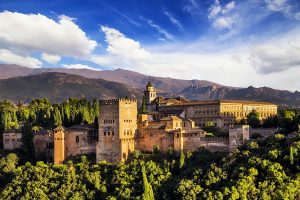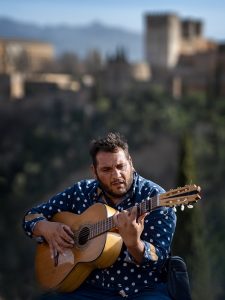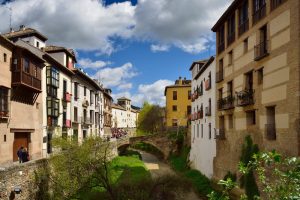
Everything you need to know for 2 or 3 days in Granada
There are so many things to see and do in Granada we usually recommend at least 2 nights in the city whether visiting on a short break or as as part of a broader tour of Andalucía . Here’s our guide covering all the Granada highlights…
Granada, the last Spanish city to fall to the Catholic Reconquista and dominated by the truly splendid Alhambra Palace, an unmissable part of any tour of Moorish Spain, but even without that it’s a wonderful city to visit. One of Spain’s most important university towns and still today a cultural melting-pot with large Muslim and Gypsy communities, here you’ll find lively bars with amazing free tapas, street stalls selling African wares and authentic flamenco shows.
The star of the show is of course the Alhambra Palace built by the Nasrid Sultans in the 11th century and still breathtakingly beautiful today. Allow half a day for the walking tour and another hour to watch the sun go down on the palace from the Mirador de San Nicolás in the gypsy neighbourhood of Albaicin.
Granada Cathedral houses the Royal Chapel with the tombs of the Catholic Kings, Ferdinand and Isabel, and sits at the heart of the Old Town where, as well as tapas bars, there are many north African restaurants, shops and stalls and from there it’s a nice (uphill!) walk to the Albaicin for flamenco shows and that view of the Alhambra with the Sierra Nevada as a backdrop.
Table of Contents
Granada Highlights – 7 things to see and do in Granada
- Alhambra Palace & Generalife Gardens
- Granada Cathedral and Royal Chapel
- Barrio del Albaicín and its Mirador de San Nicolás
- Sacromonte Caves
- Carrera del Darro
- Science Park (Parque de las Ciencias)
- Huerta de San Vicente
Things to See and Do in Granada Province – Out and About
Practicalities – Frequently asked questions about things to see and do in Granada
Granada Highlights
Alhambra Palace & Generalife Gardens
The symbol of Granada
So called because of its reddish walls (its name means Red Castle in Arabic), the Alhambra gives us the image of such an austere structure that it is impossible to imagine the marvels we will find inside. Strategically located on the Sabika hill with the Darro River flowing through a deep ravine on the north, it offers splendid views of the city of Granada and the neighbourhoods of the Albaicin.
Due to its location, it is believed that there was once a Visigoth fortress, part of which was used by the Muslim conquerors to build the Alcazaba in the
11th century. Later on, the founder of the Nasrid Dynasty transferred his residence to the site beginning the construction of the palaces and walls.
The principal elements of the complex are the Nasrid Palaces, the Generalife, the Alcazaba, magnificent gardens and grounds and the Palace of Charles V with its two museums. Though part of the original buildings were demolished or renovated and despite the massive numbers of tourists it daily receives, the Alhambra remains undisturbed, elegant and secret.
Book well ahead and allow at least half a day of your time to visit this jewel and it will take you back to the most glorious period of Granada´s Kingdom.
Granada Cathedral and Royal Chapel
A religious Renaissance treasure
On the site of a former mosque, Granada Cathedral´s first stone was laid in 1523 by express order of Queen Isabel. The architect Enrique Egas designed it in Gothic Style but, five years later, his successor – Diego of Siloam – persuaded the kings to transform it into Renaissance style. As a result, one of the finest Renaissance religious buildings in Spain was erected.
Over the long period of construction – it was finally inaugurated in 1704 – distinctive elements of the various master builders were introduced providing the structure with its unique personality.
Next to the Cathedral, you will find the Royal chapel where Isabella I of Castile and Ferdinand V of Aragon, the Catholic Kings, are buried. It also houses the remains of their heirs, Joanna I and Philip I as well as the Prince Michael.


Barrio del Albaicín and its Mirador de San Nicolás
A well-kept treasure with Alhambra´s best views
Stretching from the banks of the Darro river to the slopes of the surrounding hills, the Albaicin neighbourhood is one of the other treasures Granada has kept for us. Its origins date back to the birth of the city itself, when Iberians and Romans settled on these hills.
During the Islamic period, it was a prosperous district becoming a maze of narrow streets, small squares, whitewashed houses and mosques. After the reconquest, when the Muslim inhabitants were expelled and some buildings modified or demolished, its history has passed through alternating periods of wealth and decline.
Nowadays, the Albaicin offers an interesting mixture of Moorish and Christian influences complemented by its difficult geography of intriguing corners, secret gardens, steep and zigzag streets, aljibes (water tanks) and splendid views of the Alhambra. There are also lots of squares with open-air restaurants perfect for chilling out.
San Nicolás viewpoint offers the best views of the Alhambra across the valley, go at sunset, it’s always busy but definitely worth it!
Sacromonte Caves
The Sacred Mountain
This mystic neighbourhood’s name literally means “sacred mountain”. The place was traditionally occupied by the Gitanos (Romani people). A series of roads winding up the mountain are anked by caves that are literally carved out of the side of the mountain. They served as the original dwellings for this area’s first inhabitants. Many of the caves are still used as houses whilst others have been converted to restaurants and bars. Until recently Sacromonte was considered somewhat dangerous and only the intrepid travelled there but nowadays visitors can explore the caves, learn about the history of the area, and experience authentic flamenco shows.
Carrera del Darro
Charming old Granada
This picturesque street runs along the banks of the Darro River, down below the Albaicin, and is lined with historic buildings, charming cafes, and artisan shops. It’s a great place to take a leisurely stroll and admire the beauty of old Granada. Starting from the Plaza de Santa Ana, at the far end you’ll find a nice square, Plaza de Padre Manzón, with terraces set below the Alhambra (lovely at night when it’s all lit up). If you’re feeling energetic you can carry on, cross the river and follow the Camino Fuente del Avellano which follows the ancient water course feeding the city and offer yet more stunning views of the palace.
Science Park (Parque de las Ciencias)
A must for science lovers
Located a little way outside the city centre, this impressive science museum is the biggest in Spain and a great place for families and science enthusiasts. It features exhibits on astronomy, biology, physics, and more, as well as a planetarium and a butterfly house.
Huerta de San Vicente
Pieces of Spain´s history
Federico Garcia Lorca, one of Spain ’s most famous and enlightening poets, spent his summers here between 1926 and 1936 before being assassinated in a village nearby by Franco’s men at the beginning of the Civil War. Accompanied by his family during those years, it is here where he wrote some of his best known works.
This museum, next to the fairly new park dedicated to the poet, exhibits his desk and piano, some of his drawings and other memorabilia and holds exhibitions connected to his life and work.
Calle Virgen Blanca s/n. Parque de Federico Garcia Lorca. Opening hours: 10.00 – 16.30. Closed on Mondays.
Things to See and Do in Granada Province
Sierra Nevada National Park
Unesco Biosphere Reserve
With the highest peak of the Iberian Peninsula – Mulhacén at 3.482mts – and several other summits above the 3000mts, Sierra Nevada was declared a Unesco Biosphere Reserve in 1986 for its exceptionally diverse flora and fauna. It rises up between the provinces of Granada and Almería creating a magnificent horizon of hilly peaks which, on clear days, can be seen from as far away as Africa!
The rich history of Sulayr, Mountain of the Sun as it was called by the Muslims, is marked by glacial erosion, deep valleys, cirques, lakes, lateral moraines and ridges dating back to the Quaternary period. The Tartessians, Visigoths, Romans and Moors have all left their legacy in the area, which can be still evidenced today.
Sierra Nevada´s ski resort, at the foot of Mount Veleta, is just 30kms away from the city of Granada but, many more activities are available to those who want to appreciate the beauty of these mountains – I the summer it’s worth the drive if only to get some fresh air!
NB – in spring and autumn do take care if panning a walk in the Sierra – the temperature difference can be quite extreme!
The Alpujarra Valley
Driving over Lemons
On the south of the Sierra Nevada the tranquil Alpujarra valley was unknown to tourists until Chris Stewart (formerly of the band Genesis) oved there and wrote the evocative book ‘Driving Over Lemons’ about his experiences.
A veritable ‘time bubble’ with terraced farmland, white-washed villages clinging to the hillsides, and breathtaking views of the surrounding mountains, the Alpujarra Valley offers an idyllic setting. Its charming villages, such as Pampaneira, Bubión, and Capileira, showcase Moorish architecture and a rich cultural heritage including fascinating irrigation systems installed by the Moors over 1000 years ago.
Fuente Vaqueros
Birthplace of a star
Casa Museo Federico Garcia Lorca, Lorca’s birthplace, this house-museum, enchantingly brings the poet and dramatist, back to life. Simple, but indescribably moving, the photos, posters and paintings and costumes for the the plays he wrote and directed, leave you spellbound. Opening hours: Weekdays: 10.00- 16.00. Sundays: 10.00 – 14.00 . Closed on Mondays.
The village itself is workaday, but has a wonderful little restaurant (Meson El Hijuelo) with so much Lorca memorabilia it is an extension of the museum itself.
There are regular buses from Granada.
Eat, Drink, Dance, Nap
Eating and drinking in Granada
As with the rest of Andalucia, the cuisine of Granada is an interesting blend of the different civilizations who left their mark on the city. The Moors, particularly, are responsible for so many of the essential ingredients – citrus fruits, figs and dates, herbs and spices to name a few.
The province of Granada seems to have it all – seafood and fish and tropical fruit from the coast, meats and sausages from the Alpujarras, vegetables from La Vega and cheeses and olive oil and olives, naturally, from Montefrio.
Local dishes include “habas con jamón” (broad beans with ham), “pipirrana” (a tomato, pepper and onion salad garnished with boiled eggs), “tortilla sacramonte” (an omelette with offal and vegetables of gypsy origin), “esparragos cazuela” (asparagus cooked with ham and almonds) “olla de San Anton” (a hearty stew of different meats, chickpeas and potatoes and spices), ”zalamandrona” (a fish stew, dating back to Moorish times), “choto al ajillo” (baby goat in a garlic and wine sauce) “plato Alpujarreno” (poor man’s potatoes accompanies by ham, chorizo, black pudding and fried eggs) and “jamon de Trevelez” (ham from the highest village in the Alpujarras). Popular desserts are Arab sweetmeats and “piononos” (custard-filled pastry, the shape said to resemble the hat of the pope).
And one thing you will find everywhere is “pan de Alfacar” (crusty bread baked in a wood fired oven, from the municipality of Alfacar, using the spring water from there).
The best way to sample many of these local delicacies is “to do as the Romans do” and go tapa hopping, particularly in the evenings. Tapas are usually included in the price of a drink and the more drinks you have, the better the tapa!
For the sweet toothed, you will be surprised by the number of “teterias” (Arab tea houses) you will find throughout the city, offering the most tempting sweetmeats and pastries.
Flamenco – one of the essential things to see and do in Granada
Like in most of Andalucian cities, there is a wide variety of tablaos (dance floors where flamenco is performed) in Granada, some with twice or even thrice nightly shows of usually about an hour long. The performers change regularly. There’s much debate over which is the most authentic flamenco experience but in some part it’s tourism that keeps this fascinating art form alive – so we say ‘go with the flow’!
Taking it easy in Granada
Our top tip for getting the most out of your visit
Granada’s such an exciting city with so much to see and do whilst at the same time having one of the hottest climates in Europe – which can easily be an exhausting combination!
We recommend you ‘go native’ and take time and head indoors for a decent rest in the hottest hours of the day.
This is especially true in the summer but will help you adjust to the local rhythms at any time of the year. It’s easy to burn out and be heading to bed before the locals have come out to play of an evening, and you really don’t want to miss the genuine buzz of Granada´s tapas bar!
Frequently Asked Questions about Things to See and Do in Granada
How to get to Granada?
By air from the UK (nearest airports are Málaga and Sevilla)
- From Heathrow to Malaga with BA
- From Gatwick to Malaga with BA, Vueling, TUI or Whizzair; Sevilla with Easyjet, Vueling or BA
- From Stansted to Jerez or Sevilla with Ryanair; Malaga with Ryanair or Jet2
- From Luton to Sevilla with Ryanair; Malaga with Easyjet or Ryanair
- From Manchester to Sevilla with Ryanair; Malaga with Easyjet, Jet2, TUI or Ryanair
- From Bristol to Malaga with Ryanair or Easyjet
- From Dublin to Malaga with Ryanair and Aer Lingus
- From Edinburgh to Sevilla with Ryanair; Malaga with Ryanair
When to go to Granada?
From late March through to early June then mid September to early November are perhaps the best months to visit Granada.
Summer temperatures can often reach the low 40s Centigrade – so best avoided unless you really like the heat (though with air-conditioning and a siesta it can be made possible, and the city is at its quietest).
At the high altitudes of Sierra Nevada the temperatures are more intense – harshly cold in winter and extremely hot in the summer.
How long to stay in Granada?
Normally we recommend two nights when taken as part of an Andalucía touring holiday though, if you have more time and prefer a more relaxed pace, there’s no end of things to see in the city.
You could also do a day trip to discover the amazing scenery of Sierra Nevada Natural Park or visit nearby Fuente Vaqueros, birthplace of the famours poet Federico García Lorca.
What to eat in Granada?
As mentioned above, the cousine of Granada is an interesting blend and probably the best way to taste many of the local delicacies is to go tapa hopping. Don´t miss the “habas con jamón” (broad beans with ham), the “olla de San Anton” (a hearty stew of different meats, chickpeas and potatoes and spices) or try the cheeses and olives from Montefrio and the peculiar “tortilla sacramonte” (an omelette with offal and vegetables of gypsy origin).
There is also a surprising number of “teterias” (Arab tea houses) that you will find throughout the city, offering the most tempting sweetmeats and pastries.
What to buy in Granada?
You’ll find plenty of souvenir shops selling the ‘typical Spanish’ and all kind of Arab style bric-a-brac wherever you go in Granada.
For a classy, easy-to-pack and authentic memoir (which you might find very useful during your stay) look out for artisan-made folding fans or ‘abanicos’. There are plenty of shops in the Alcaiceria and neighborhoods like the Albaicín where you can also find nice pieces of Zafalauja pottery (decorated with geometric motifs in shades of green and blue), swals and mantillas or handmade replicas of Granada lamps.
If you visit the above mentioned Alpujarra Valley, take a look at the jarapas (quilts or rugs made with recycled fabrics of various colors). You may not want to leave without one.
And if you are into cooking, the Morrocan-style herbalists in the Carrera del Darro or near the Cathedral will surprise you with a wide variety of medicinal plants, aromatic flowers, and spices.




